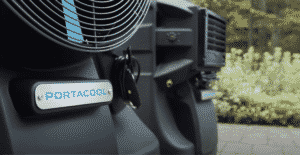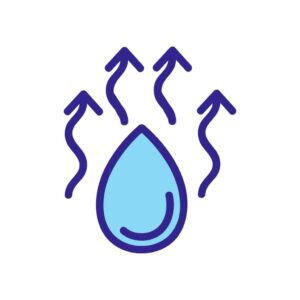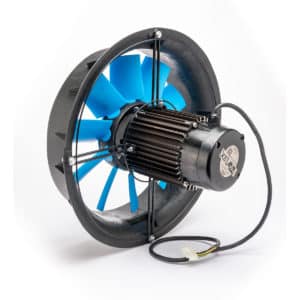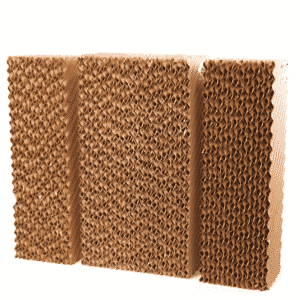
Swamp coolers are a powerful technology that are able to dramatically cool the air with very low energy use. But how does this marvelous technology actually work? It’s very simple, really: it takes energy to evaporate water. By taking that energy from the air, an evaporative cooler reduces the temperature of the air.
Of course, the details are a lot more complicated than that, and modern swamp coolers, more commonly referred to as evaporative coolers, are remarkable improvements over their primitive predecessors.
 It takes a lot of energy to turn a liquid into a gas. When molecules are in a liquid, they are bound to each other. They cling together, which is what creates surface tension and lets you siphon fluids, like emptying a gas tank or cleaning a fish tank. In order to become a gas, molecules have to be broken free from each other.
It takes a lot of energy to turn a liquid into a gas. When molecules are in a liquid, they are bound to each other. They cling together, which is what creates surface tension and lets you siphon fluids, like emptying a gas tank or cleaning a fish tank. In order to become a gas, molecules have to be broken free from each other.
Different liquids require different amounts of energy to break away. Water is one of the most energy-intensive types of liquid. That’s because each water molecule is a little magnet, and they all stick together. If you’ve ever played with the bin full of magnetite at your local rock shop or natural history museum, you get a sense of why it takes a lot of energy to get water molecules free.
How much energy does it take? About 890 BTU per pound (pint) of water. That means that for every gallon of water evaporated, we get about 2kWh of “free” cooling. Swamp coolers take advantage of this free cooling to reduce the temperature of your home.
Portacool evaporative coolers are an advanced application of the swamp cooler principles. To achieve maximum cooling, Portacools are made of:
Portacools take on a big challenge for an evaporative cooler: being so portable that they can be moved easily to any application by one person in most situations. However, two might be required if the swamp cooler must be lifted. We accomplish this with roto-molded high-impact plastic housings, which we make at our in-house plastics division.
Another way that we make our Portacools portable is to supply each unit with a set of sturdy casters that allows them to roll easily around the spaces where you want to use them.
A motor drives the fan. We usually utilize two- or three-speed motors to allow for adjustable airflow. This helps people get the level of cooling they want from their Portacool.
 The fan is what pulls air over the evaporative media to encourage evaporation. It also propels the air out of the Portacool to cool the spaces you want.
The fan is what pulls air over the evaporative media to encourage evaporation. It also propels the air out of the Portacool to cool the spaces you want.
For some of our Portacools, mostly the Cyclone series, we use centrifugal fans that can drive a significant amount of air in a compact space. However, for most of our Portacools, we use standard axial fans.
The reservoir holds water for the Portacool. Depending on the size of the unit, this reservoir could be up to 75 gallons. This lets your Portacool keep cooling for a long period of time, even if it can’t be connected to a constant water supply.
A float valve is an old piece of technology, but it still works great to keep the reservoir of a Portacool from overfilling when attached to a constant water supply.
On the other hand, running out of water could potentially damage components of your Portacool, especially the pumps. That’s why all Portacools now have low-water shutoff valves.
In order to be effective, the evaporative media of a swamp cooler must be wetted constantly. That’s what our pump is for. It pumps water up through tubes to the top of the evaporative media, so we don’t depend on wicking alone for wetting.
Although a Portacool does a fair job of managing its water level independently, if you’re filling it manually, you want to be able to check the water level. Our LLI lets you see the water level quickly so you can refill it rather than just waiting for it to run out.
With this valve, you can further customize the cooling in your Portacool. Turn up the water for more evaporation and more cooling. Turn it down for less cooling.
 Evaporative media is one of the places where Portacool stands apart from its competition. It’s also the secret that helps modern evaporative coolers work so effectively.
Evaporative media is one of the places where Portacool stands apart from its competition. It’s also the secret that helps modern evaporative coolers work so effectively.
The amount of cooling you can get out of an evaporative cooler depends on the amount of water you can evaporate. The amount of water you can evaporate depends on how much water you can get in contact with the air. You’ve probably noticed how having wet hair makes you colder than having just damp skin. That’s because your hair has more surface area, allowing more water to evaporate, which provides more cooling.
In primitive times, people would increase the water contact with air by making long, shallow pools for air to pass over, or using blankets or rough-spun cloth to soak up the water. Modern evaporative coolers depend on their evaporative media to maximize their ability to cool air.
In principle, evaporative media is like a sponge that soaks up the water. However, it lets air pass through. As the air passes through, it evaporates the water it comes in contact with, which creates the cooling effect.
At Portacool, we use our own unique evaporative media, made by our subsidiary Kuul™. The specific models of Kuul Comfort™ evaporative media are designed to maximize the efficiency of operation of each Portacool model. We even have special flame retardant evaporative media for our Hazardous Location series.
Hopefully, this explanation helps you understand the basics and details of how a swamp cooler functions. If you have additional questions, peruse our FAQ section to see if you find the answers you’re looking for.
If not, please use our online contact form to ask a question. If you’re ready to move ahead with purchasing a Portacool, you can use our website to find a retailer.